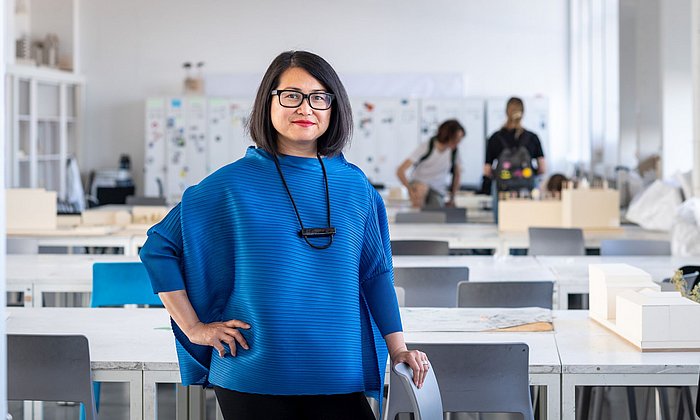NewIn: Katja Thoring
How work environments shape creativity
How did you get into design?
I tried a lot: from graphic design and interface design to interior architecture and product design. My interdisciplinary approach and curiosity led me to Integrated Product Design, where all these aspects come together. Driven by the same curiosity, I later turned to research. As a professor, it is important to me to inspire my students and pass on this passion for new ideas. At the same time, I am constantly learning through teaching.
What makes a creative workspace?
A creative workspace is an environment that supports creative work. This includes aspects such as equipment and furniture at the object level, and interior design with factors such as acoustics, lighting, or wall color. The architecture also plays a role, such as the size of windows, views, or stairs as a meeting place. Finally, the location in the urban context is important: the proximity to infrastructure for material procurement and/or the surrounding nature. All these elements influence the work processes. For example, an upright sitting position with limited vision can support concentration and focused work, while the opportunity for movement and activity supports creative thinking.
We see a lot of creative workspaces these days. What do you think about startup lofts with big poofs and ping-pong tables?
In principle, it's a good thing to think about how to make the workplace more fun. However, some concepts, such as providing ping-pong tables, climbing walls and slides, don't appeal to everyone and are often aimed at a younger target group. Another critical point is that such offerings can encourage people to work longer hours. For example, free pizza after 9 p.m. or paid taxi rides after midnight may seem attractive but could encourage employees to work overtime. So these policies are not always altruistic. They also reflect the culture of the organization. Traditional companies may not offer these amenities, while innovation-focused startups are more likely to integrate them. It is important that these facilities are not just a frill, but part of the office culture.
What is the focus of your research on the design of creative work environments?
My current focus is on the development of hybrid and virtual workspaces, especially with regard to the integration of physical space qualities. At the same time, I am leading a project on biophilic design, which explores the integration of nature into work environments and its scientifically measurable effects on well-being and creativity. In this context, we are conducting experimental studies to obtain objective data on creativity in addition to subjective surveys. Another exciting aspect is the role of Artificial Intelligence in the world of work and the exploration of new working methods and environments. These technological developments will permanently change the world of work, although the exact effects and forms are still uncertain.
What does your own workplace look like?
Together with my team, I want to make the workplace at TUM creative and conducive to creativity. Here, we not only implement our research, but also try out suggestions in practice. At home, I prefer to work comfortably on the sofa because my desk is often too chaotic. However, my most productive hours are when I'm traveling. I'm most creative and focused on my writing when I'm away from home, with a view of the water or the countryside.
What's next for the subject area Design at TUM?
My two main tasks here at the moment are setting up the Munich Design Institute together with Annette Diefenthaler and the establishment of a new design degree program - both great and exciting challenges.
With over 300 design courses in Germany, the challenge is to develop a unique program that stands out from the crowd. By its very nature, design is highly interdisciplinary, and TUM's interdisciplinary orientation offers unique opportunities. Collaboration with medicine, computer science, engineering, sports and social sciences could be a unique selling point of our design program.
I hope that potential students will recognize this special opportunity and find it attractive to study design in such a diverse environment.
- Katja Thoring studied Industrial Design at the Berlin University of the Arts and at the California College of the Arts, San Francisco. She completed her doctorate in Design Research at TU Delft and was a professor in Dessau until 2022. Since 2023, Katja Thoring heads the Chair of Integrated Product Design at TUM.
- The chair is funded by the Hightech Agenda Bavaria.
- All episodes NewIn.
Technical University of Munich
- Sophia Pritscher / Andreas Schmidt
- a.schmidt@tum.de
Contacts to this article:
Prof. Katja Thoring
Chair of Integrated Product Design
Technical University of Munich



